A Sustainable Amine Magnetic Biocomposite Based on Rice Husk–Sugarcane Bagasse Fiber for Lead and Contaminant Adsorption in Aqueous Solution
Abstract
1. Introduction
2. Materials and Methods
2.1. Materials
2.2. Rice Husk and Sugarcane Bagasse Delignification Process
2.3. Preparation of the Amine Magnetic Biocomposite Based on Rice Husk and Sugarcane Bagasse Fiber
2.4. Simultaneous Adsorption of Pb(II) ions, Chemical Oxygen Demand (COD), Total Suspended Solid (TSS), and Dye of the Amine Magnetic Biocomposite
2.5. Characterization of Material
2.6. Analysis
3. Results and Discussion
3.1. Amine Magnetic Biocomposite Characterization
3.2. Kinetics Study of Pb(II) Ion Adsorption Using the Amine Magnetic Biocomposite as an Adsorbent
3.3. Adsorption Isotherm Study of Pb(II) Ions Using the Amine Magnetic Biocomposite as an Adsorbent
3.4. pH Effect on Pb(II) Ion Adsorption Capacity, Chemical Oxygen Demand (COD), Total Suspended Solid (TSS), and Dyes in Aqueous Solution Using the Amine Magnetic Biocomposite
3.5. Reusability Performance of Amine Magnetic Biocomposites for Pb(II) Ion Adsorption
4. Conclusions
Author Contributions
Funding
Institutional Review Board Statement
Informed Consent Statement
Data Availability Statement
Acknowledgments
Conflicts of Interest
References
- Nata, I.F.; Putra, M.D.; Nurandini, D.; Irawan, C.; Fitriani, R.; Isnaini, M.D. Rice Husk Fiber Magnetic Nanoparticle Biocomposites: Preparation and Characterization. IOP Conf. Ser. Earth Environ. Sci. 2018, 175, 012005. [Google Scholar] [CrossRef]
- Supranto, S.; Tawfiequrrahman, A.; Yunanto, D.E. Sugarcane Bagasse Conversion to High Refined Cellulose Using Nitric Acid, Sodium Hydroxide and Hydrogen Peroxide as the Delignification Agents. J. Eng. Sci. Technol. 2015, 1, 35–46. [Google Scholar]
- Ilindra, A.; Dhake, J.D. Microcrystalline Cellulose from Bagasse and Rice Straw. Indian J. Chem. Technol. 2008, 15, 497–499. [Google Scholar]
- Dewi, Y.S.; Wijayanti, H.; Lestari, R.A.; Nata, I.F. Preparation of magnetic nanoparticle biocomposites using rice husk and sugarcane bagasse fibers as the matrix. IOP Conf. Ser. Mater. Sci. Eng. 2020, 980, 012007. [Google Scholar] [CrossRef]
- Hameed, B.H.; Ahmad, A.A. Batch adsorption of methylene blue from aqueous solution by garlic peel, an agricultural waste biomass. J. Hazard. Mater. 2009, 164, 870–875. [Google Scholar] [CrossRef]
- Rokbi, M.; Osmani, H.; Imad, A.; Benseddiq, N. Effect of Chemical treatment on Flexure Properties of Natural Fiber-reinforced Polyester Composite. Procedia Eng. 2011, 10, 2092–2097. [Google Scholar] [CrossRef]
- Karp, S.G.; Woiciechowski, A.L.; Soccol, V.T.; Soccol, C.R. Pretreatment strategies for delignification of sugarcane bagasse: A review. Braz. Arch. Biol. Technol. 2013, 56, 679–689. [Google Scholar] [CrossRef]
- Guimarães Gusmão, K.A.; Alves Gurgel, L.V.; Sacramento Melo, T.M.; Gil, L.F. Application of succinylated sugarcane bagasse as adsorbent to remove methylene blue and gentian violet from aqueous solutions—Kinetic and equilibrium studies. Dye. Pigment. 2012, 92, 967–974. [Google Scholar] [CrossRef]
- Zhang, Z.; Moghaddam, L.; O’Hara, I.M.; Doherty, W.O.S. Congo Red adsorption by ball-milled sugarcane bagasse. Chem. Eng. J. 2011, 178, 122–128. [Google Scholar] [CrossRef]
- Dos Santos, V.C.G.; De Souza, J.V.T.M.; Tarley, C.R.T.; Caetano, J.; Dragunski, D.C. Copper Ions Adsorption from Aqueous Medium Using the Biosorbent Sugarcane Bagasse In Natura and Chemically Modified. Water Air Soil Pollut. 2011, 216, 351–359. [Google Scholar] [CrossRef]
- Mahmood-ul-Hassan, M.; Suthar, V.; Rafique, E.; Ahmad, R.; Yasin, M. Kinetics of cadmium, chromium, and lead sorption onto chemically modified sugarcane bagasse and wheat straw. Environ. Monit. Assess. 2015, 187, 470. [Google Scholar] [CrossRef] [PubMed]
- Hamza, I.A.A.; Martincigh, B.S.; Ngila, J.C.; Nyamori, V.O. Adsorption studies of aqueous Pb(II) onto a sugarcane bagasse/multi-walled carbon nanotube composite. Phys. Chem. Earth Parts A/B/C 2013, 66, 157–166. [Google Scholar] [CrossRef]
- Nata, I.F.; Mirwan, A.; Wicakso, D.R.; Irawan, C.; Isnaini, M.D.; Fitriani, R. Adsorption of Fe3+ ion from Aqueous Solution onto Rice Husk Biocomposite Magnetic Nanoparticle. IOP Conf. Ser. Earth Environ. Sci. 2020, 506, 012006. [Google Scholar] [CrossRef]
- Rattanachueskul, N.; Saning, A.; Kaowphong, S.; Chumha, N.; Chuenchom, L. Magnetic carbon composites with a hierarchical structure for adsorption of tetracycline, prepared from sugarcane bagasse via hydrothermal carbonization coupled with simple heat treatment process. Bioresour. Technol. 2017, 226, 164–172. [Google Scholar] [CrossRef] [PubMed]
- Yu, J.-X.; Wang, L.-Y.; Chi, R.-A.; Zhang, Y.-F.; Xu, Z.-G.; Guo, J. Competitive adsorption of Pb2+ and Cd2+ on magnetic modified sugarcane bagasse prepared by two simple steps. Appl. Surf. Sci. 2013, 268, 163–170. [Google Scholar] [CrossRef]
- Tan, Y.; Chen, M.; Hao, Y. High efficient removal of Pb (II) by amino-functionalized Fe3O4 magnetic nano-particles. Chem. Eng. J. 2012, 191, 104–111. [Google Scholar] [CrossRef]
- Cui, Y.; Liu, S.; Hu, Z.-J.; Liu, X.-H.; Gao, H.-W. Solid-phase extraction of lead(II) ions using multiwalled carbon nanotubes grafted with tris(2-aminoethyl)amine. Microchim. Acta 2011, 174, 107. [Google Scholar] [CrossRef]
- Hao, Y.-M.; Man, C.; Hu, Z.-B. Effective removal of Cu (II) ions from aqueous solution by amino-functionalized magnetic nanoparticles. J. Hazard. Mater. 2010, 184, 392–399. [Google Scholar] [CrossRef]
- Irawan, C.; Putra, M.D.; Wijayanti, H.; Juwita, R.; Meliana, Y.; Nata, I.F. The Amine Functionalized Sugarcane Bagasse Biocomposites as Magnetically Adsorbent for Contaminants Removal in Aqueous Solution. Molecules 2021, 26, 5867. [Google Scholar] [CrossRef]
- Nata, I.F.; Sureshkumar, M.; Lee, C.-K. One-pot preparation of amine-rich magnetite/bacterial cellulose nanocomposite and its application for arsenate removal. RSC Adv. 2011, 1, 625–631. [Google Scholar] [CrossRef]
- de Carvalho Neto, A.G.V.; Ganzerli, T.A.; Cardozo, A.L.; Fávaro, S.L.; Pereira, A.G.B.; Girotto, E.M.; Radovanovic, E. Development of composites based on recycled polyethylene/sugarcane bagasse fibers. Polym. Compos. 2014, 35, 768–774. [Google Scholar] [CrossRef]
- Irawan, C.; Nata, I.F.; Lee, C.-K. Removal of Pb(II) and As(V) using magnetic nanoparticles coated montmorillonite via one-pot solvothermal reaction as adsorbent. J. Environ. Chem. Eng. 2019, 7, 103000. [Google Scholar] [CrossRef]
- Panthapulakkal, S.; Law, S.; Sain, M. Enhancement of Processability of Rice Husk Filled High-density Polyethylene Composite Profiles. J. Thermoplast. Compos. Mater. 2005, 18, 445–458. [Google Scholar] [CrossRef]
- Qureshi, K.; Bhatti, I.; Kazi, R.; Ansari, A.K. Physical and chemical analysis of activated carbon prepared from sugarcane bagasse and use for sugar decolorisation. Int. J. Chem. Biomol. Eng. 2008, 1, 145–149. [Google Scholar]
- Hashemian, S.; Hosseini, S.H.; Salehifar, H.; Salari, K. Adsorption of Fe(III) from Aqueous Solution by Linde Type-A Zeolite. Am. J. Anal. Chem. 2013, 04, 123–126. [Google Scholar] [CrossRef]
- Mohadi, R.; Hidayati, N.; Lesbani, A. Adsorption Desorption of Chromium (III) Ion on Cellulose From Wood Powder. Int. J. Sci. Eng. (IJSE) 2014, 7, 77–80. [Google Scholar] [CrossRef][Green Version]
- Ghali, L.; Msahli, S.; Zidi, M.; Sakli, F. Effects of Fiber Weight Ratio, Structure and Fiber Modification onto Flexural Properties of Luffa-Polyester Composites. Adv. Mater. Phys. Chem. 2011, 01, 78–85. [Google Scholar] [CrossRef][Green Version]
- Zhang, X.; Kan, X.; Wang, M.; Rao, R.; Qian, N.; Zheng, G.; Ma, Y. Mechanism of enhanced magnetization in CoFe2O4/La0.7Sr0.3MnO3 composites with different mass ratios. Ceram. Int. 2020, 46, 14847–14856. [Google Scholar] [CrossRef]
- Nata, I.F.; Wicakso, D.R.; Mirwan, A.; Irawan, C.; Ramadhani, D.; Ursulla. Selective adsorption of Pb(II) ion on amine-rich functionalized rice husk magnetic nanoparticle biocomposites in aqueous solution. J. Environ. Chem. Eng. 2020, 8, 104339. [Google Scholar] [CrossRef]
- Lagrergen, S. Zur Theorie Der Sogenannten Adsorption Gelöster Stoffe Kungliga Svenska Vetenskapsakademiens. Handlingar 1898, 24, 1–39. [Google Scholar]
- Ho, Y.-S.; McKay, G. Pseudo-second order model for sorption processes. Process Biochem. 1999, 34, 451–465. [Google Scholar] [CrossRef]
- Pipíška, M.; Zarodňanská, S.; Horník, M.; Ďuriška, L.; Holub, M.; Šafařík, I. Magnetically Functionalized Moss Biomass as Biosorbent for Efficient Co2+ Ions and Thioflavin T Removal. Materials 2020, 13, 3619. [Google Scholar] [CrossRef] [PubMed]
- Wu, W.; He, Q.; Jiang, C. Magnetic iron oxide nanoparticles: Synthesis and surface functionalization strategies. Nanoscale Res. Lett. 2008, 3, 397–415. [Google Scholar] [CrossRef] [PubMed]
- Liu, W.; Zhao, C.; Wang, S.; Niu, L.; Wang, Y.; Liang, S.; Cui, Z. Adsorption of cadmium ions from aqueous solutions using nano-montmorillonite: Kinetics, isotherm and mechanism evaluations. Res. Chem. Intermed. 2018, 44, 1441–1458. [Google Scholar] [CrossRef]
- Chu, Y.; Khan, M.A.; Wang, F.; Xia, M.; Lei, W.; Zhu, S. Kinetics and equilibrium isotherms of adsorption of Pb(II) and Cu(II) onto raw and arginine-modified montmorillonite. Adv. Powder Technol. 2019, 30, 1067–1078. [Google Scholar] [CrossRef]
- Homagai, P.L.; Ghimire, K.N.; Inoue, K. Adsorption behavior of heavy metals onto chemically modified sugarcane bagasse. Bioresour. Technol. 2010, 101, 2067–2069. [Google Scholar] [CrossRef]
- Sun, N.; Wen, X.; Yan, C. Adsorption of mercury ions from wastewater aqueous solution by amide functionalized cellulose from sugarcane bagasse. Int. J. Biol. Macromol. 2018, 108, 1199–1206. [Google Scholar] [CrossRef]
- Gómez-Pastora, J.; Bringas, E.; Ortiz, I. Recent progress and future challenges on the use of high performance magnetic nano-adsorbents in environmental applications. Chem. Eng. J. 2014, 256, 187–204. [Google Scholar] [CrossRef]
- Zhang, X.; Li, Y.; Hou, Y. Preparation of magnetic polyethylenimine lignin and its adsorption of Pb(II). Int. J. Biol. Macromol. 2019, 141, 1102–1110. [Google Scholar] [CrossRef]
- Ji, J.; Chen, G.; Zhao, J. Preparation and characterization of amino/thiol bifunctionalized magnetic nanoadsorbent and its application in rapid removal of Pb (II) from aqueous system. J. Hazard. Mater. 2019, 368, 255–263. [Google Scholar] [CrossRef]
- Guo, S.; Jiao, P.; Dan, Z.; Duan, N.; Zhang, J.; Chen, G.; Gao, W. Synthesis of magnetic bioadsorbent for adsorption of Zn(II), Cd(II) and Pb(II) ions from aqueous solution. Chem. Eng. Res. Des. 2017, 126, 217–231. [Google Scholar] [CrossRef]
- Wang, Y.; Zhao, L.; Peng, H.; Wu, J.; Liu, Z.; Guo, X. Removal of Anionic Dyes from Aqueous Solutions by Cellulose-Based Adsorbents: Equilibrium, Kinetics, and Thermodynamics. J. Chem. Eng. Data 2016, 61, 3266–3276. [Google Scholar] [CrossRef]
- Abdel-Aziz, H.M. Effective removal of chemical oxygen demand and phosphates from aqueous medium using entrapped activated carbon in alginate. MOJ Biol. Med. 2018, 3, 227–236. [Google Scholar] [CrossRef]
- Pan, Y.; Zhu, Y.; Xu, Z.; Lu, R.; Zhang, Z.; Liang, M.; Liu, H. Adsorption Removal of COD from Wastewater by the Activated Carbons Prepared from Sugarcane Bagasse. In Proceedings of the 5th International Conference on Bioinformatics and Biomedical Engineering (iCBBE 2011), Wuhan, China, 10–12 May 2011; pp. 1–4. [Google Scholar] [CrossRef]
- Sivashankar, R.; Sathya, A.; Sivasubramanian, V. Synthesis of magnetic biocomposite for efficient adsorption of azo dye from aqueous solution. Ecotoxicol. Environ. Saf. 2015, 121, 149–153. [Google Scholar] [CrossRef] [PubMed]
- Alsuhybani, M.; Alshahrani, A.; Algamdi, M.; Al-Kahtani, A.A.; Alqadami, A.A. Highly efficient removal of Pb(II) from aqueous systems using a new nanocomposite: Adsorption, isotherm, kinetic and mechanism studies. J. Mol. Liq. 2020, 301, 112393. [Google Scholar] [CrossRef]
- Tan, Y.; Wang, K.; Yan, Q.; Zhang, S.; Li, J.; Ji, Y. Synthesis of Amino-Functionalized Waste Wood Flour Adsorbent for High-Capacity Pb(II) Adsorption. ACS Omega 2019, 4, 10475–10484. [Google Scholar] [CrossRef] [PubMed]
- Jafarnejad, M.; Asli, M.D.; Taromi, F.A.; Manoochehri, M. Synthesis of multi-functionalized Fe3O4-NH2-SH nanofiber based on chitosan for single and simultaneous adsorption of Pb(II) and Ni(II) from aqueous system. Int. J. Biol. Macromol. 2020, 148, 201–217. [Google Scholar] [CrossRef]
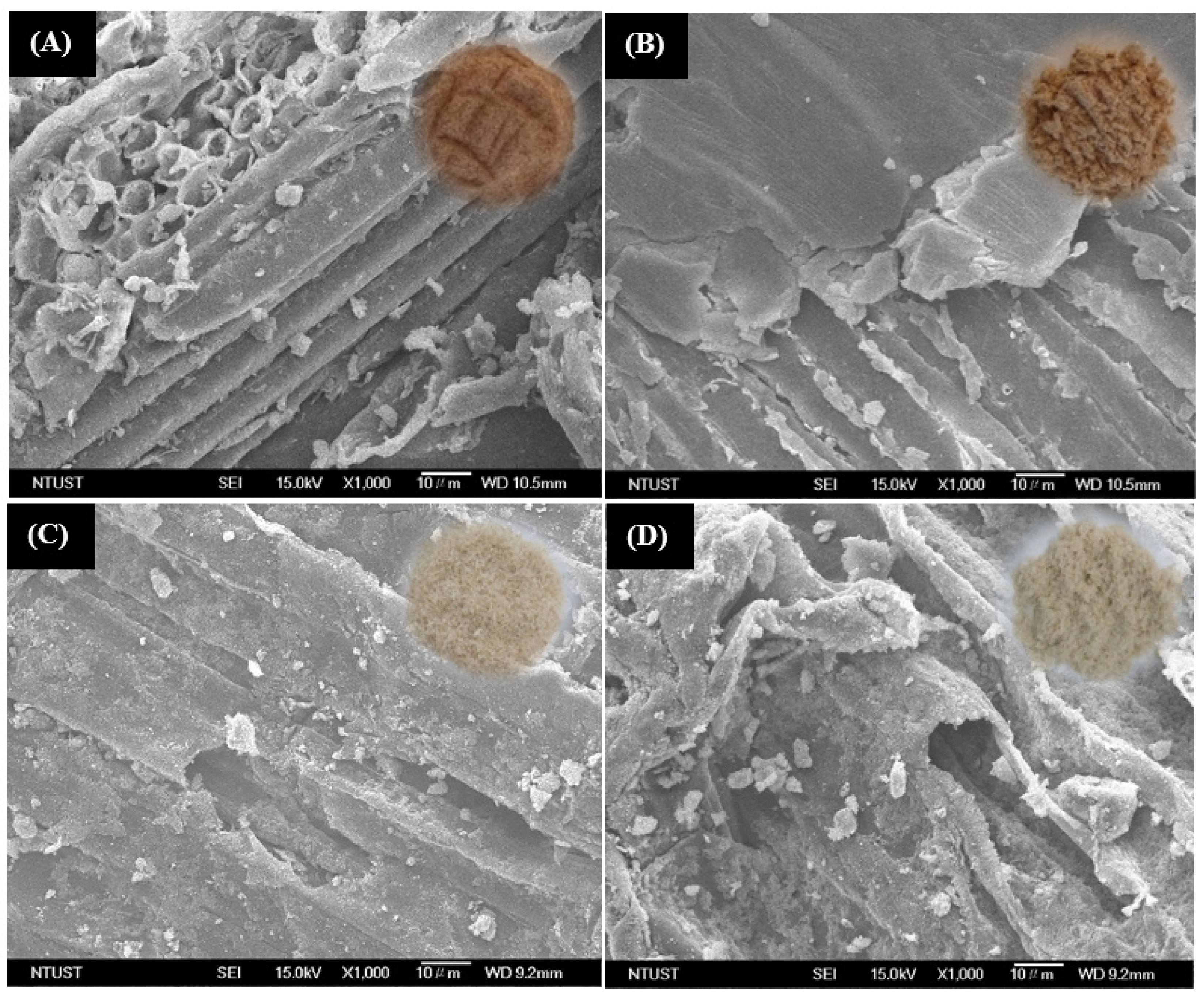
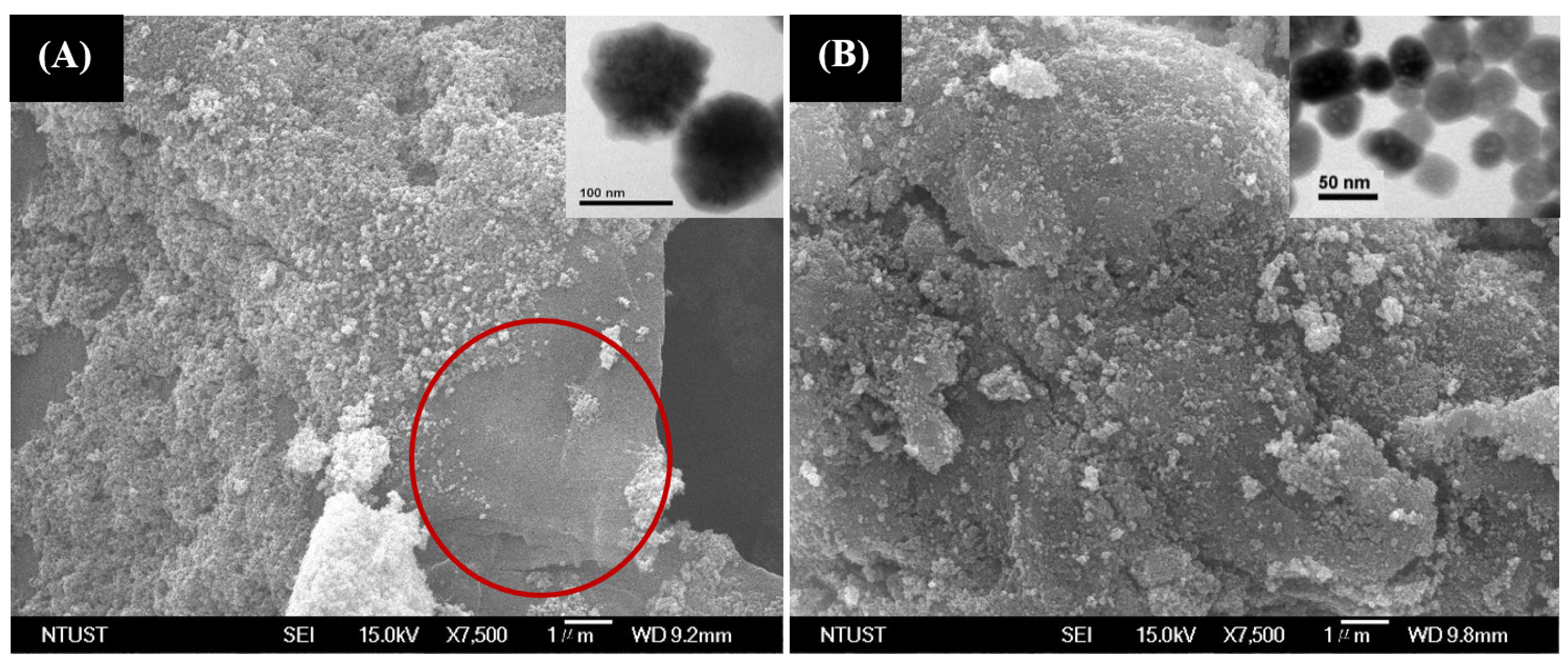
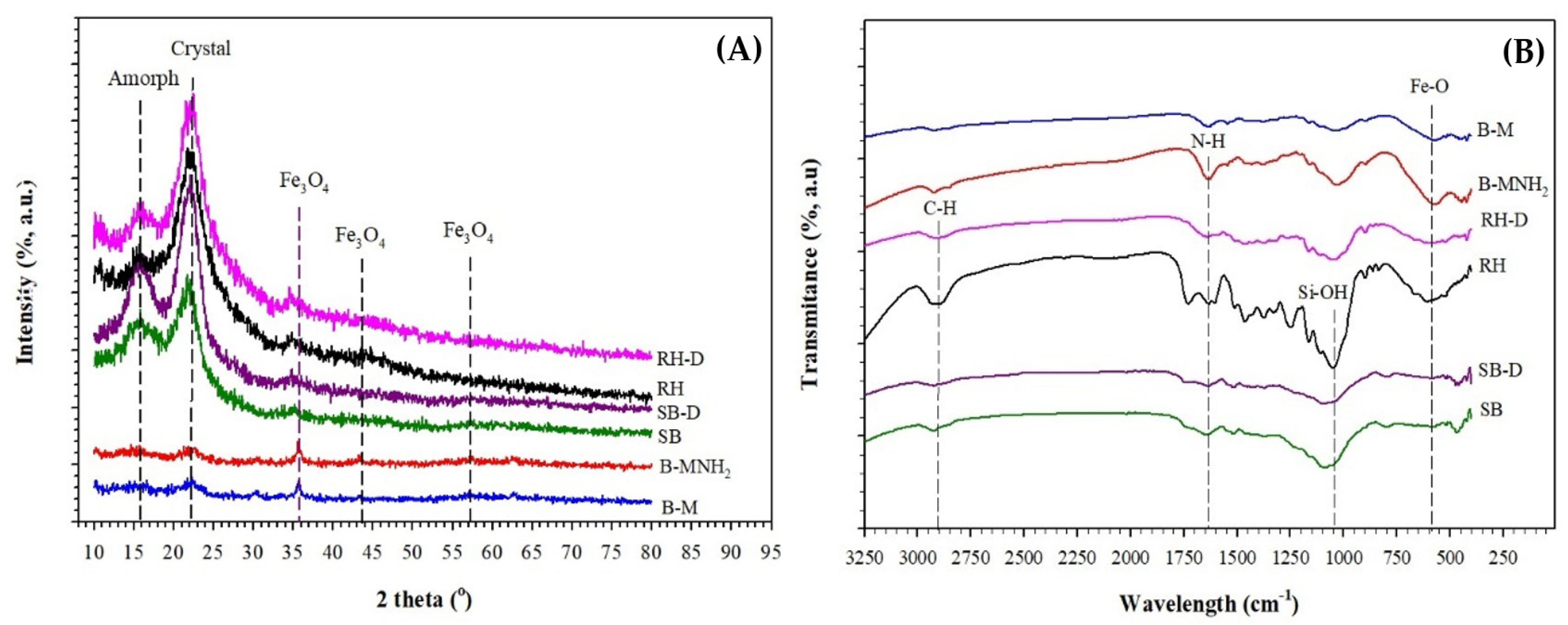
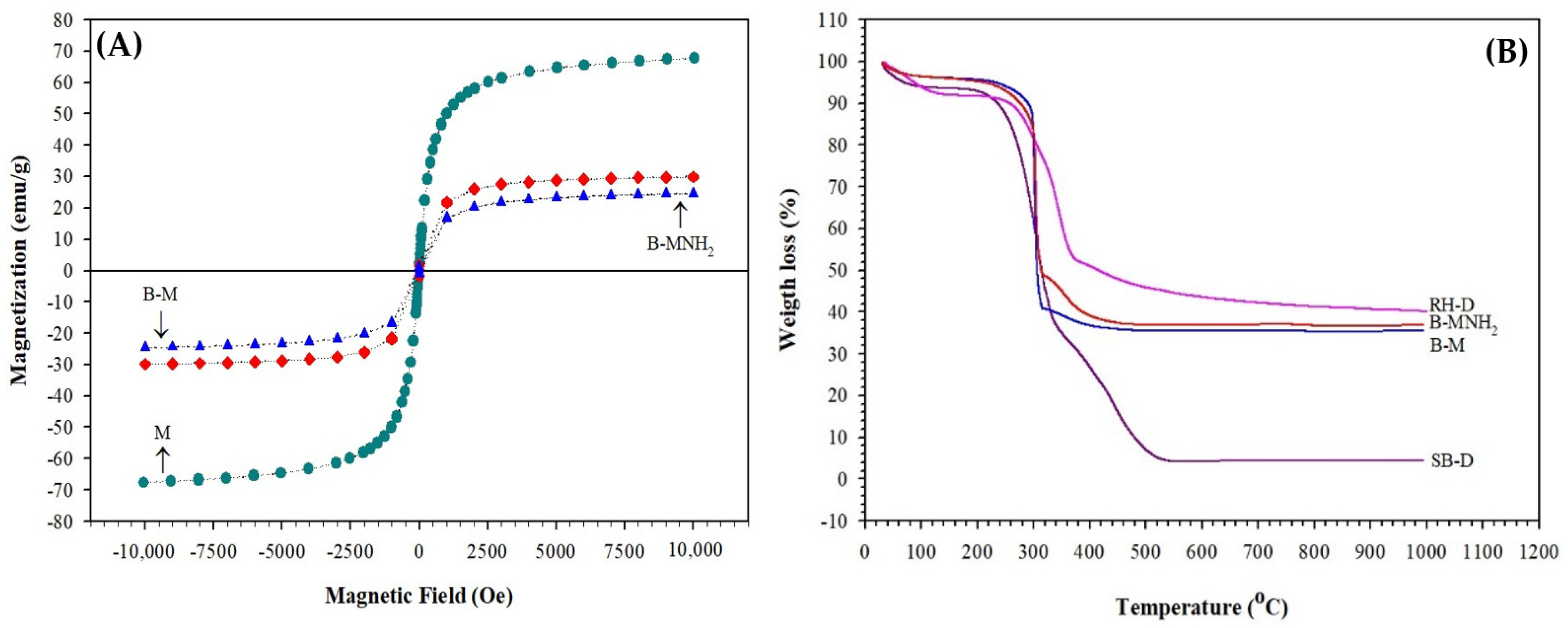

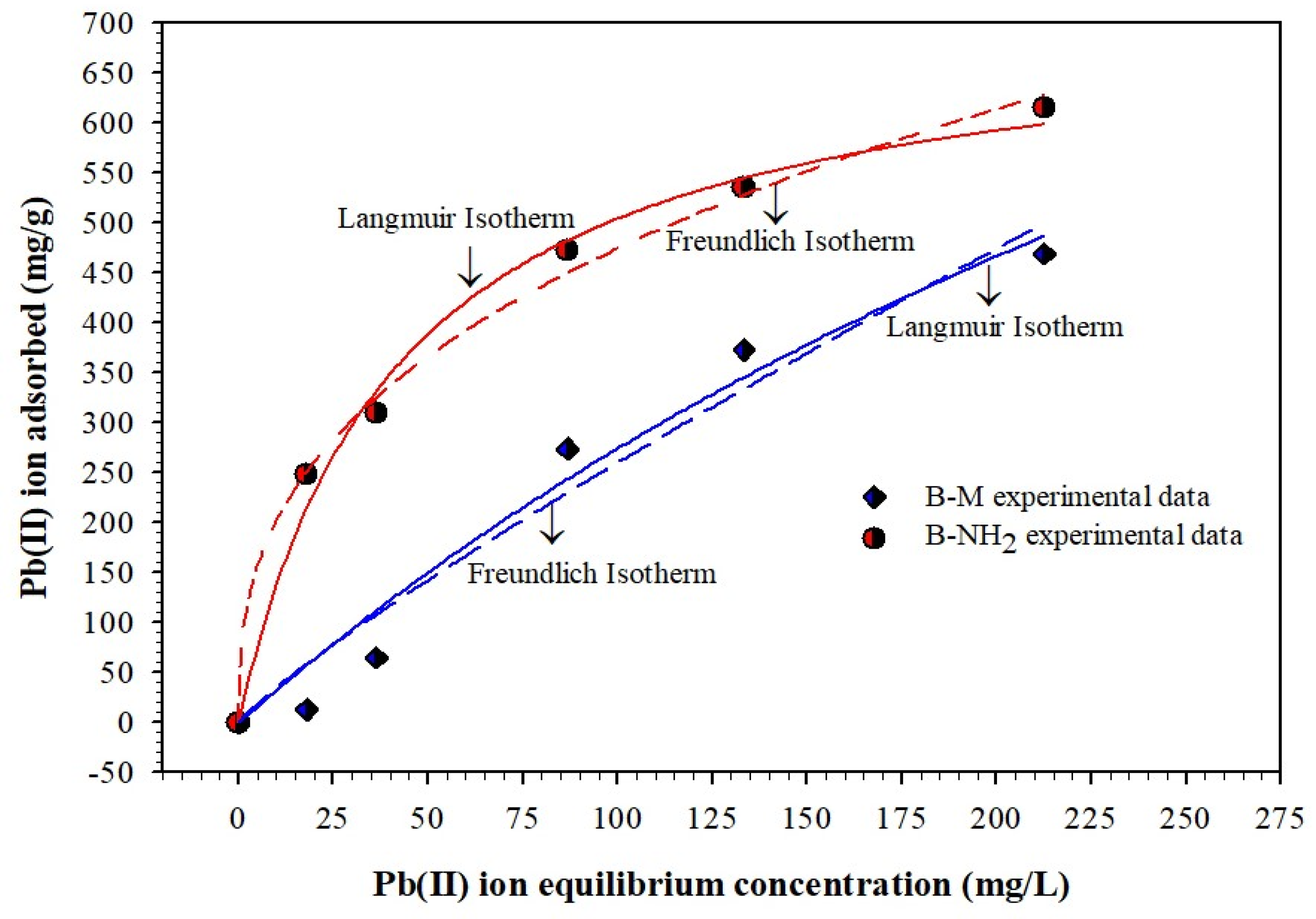
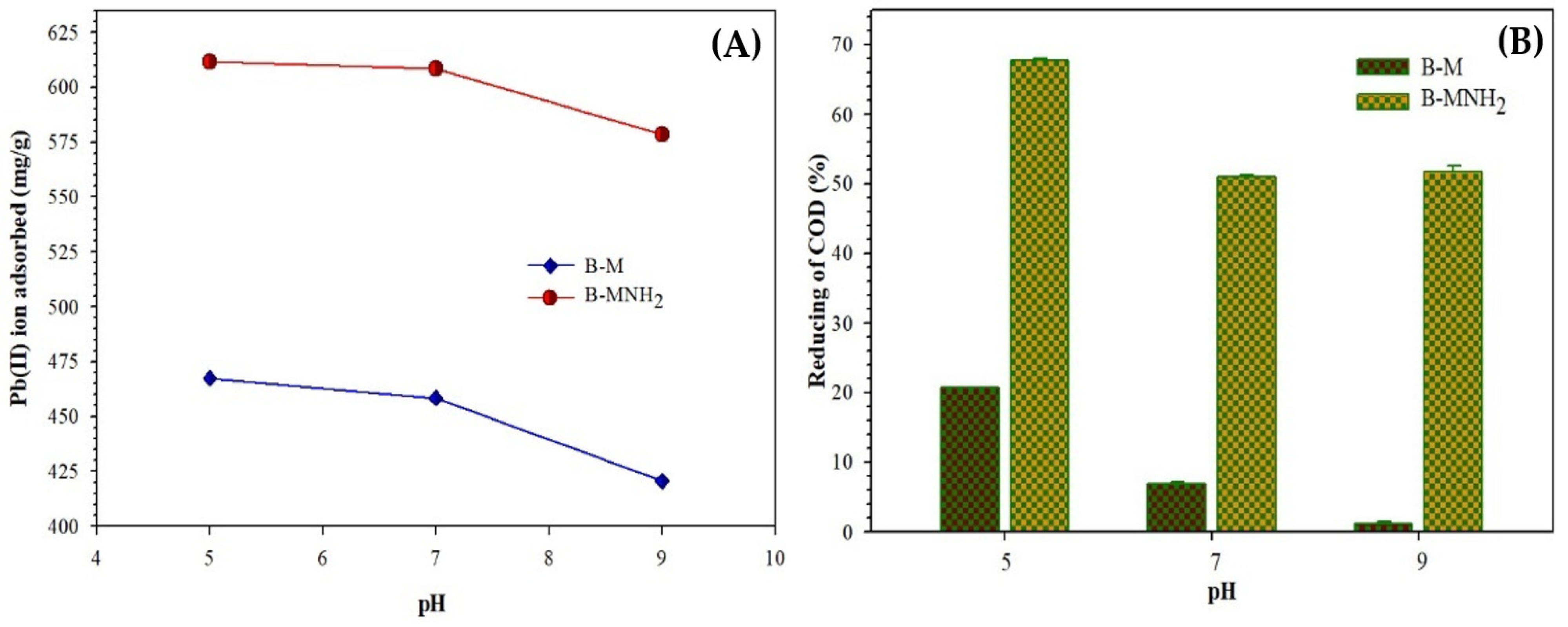
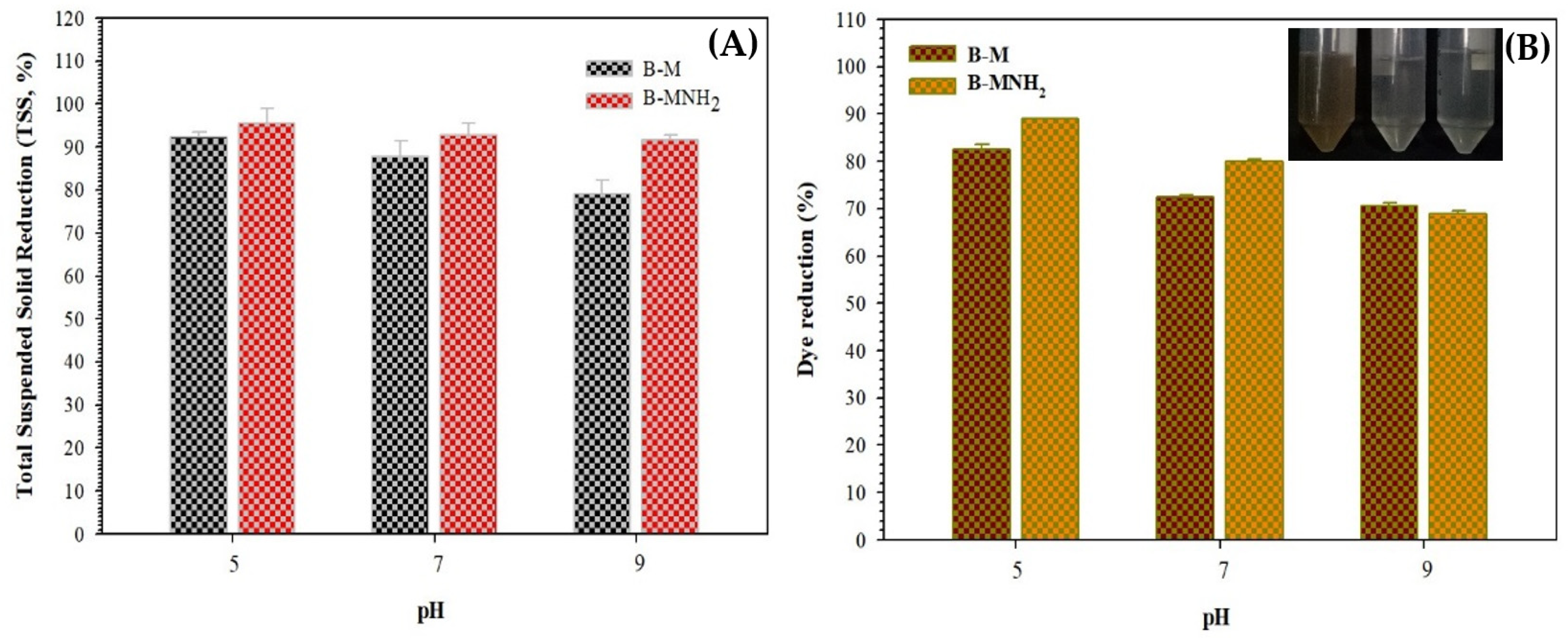
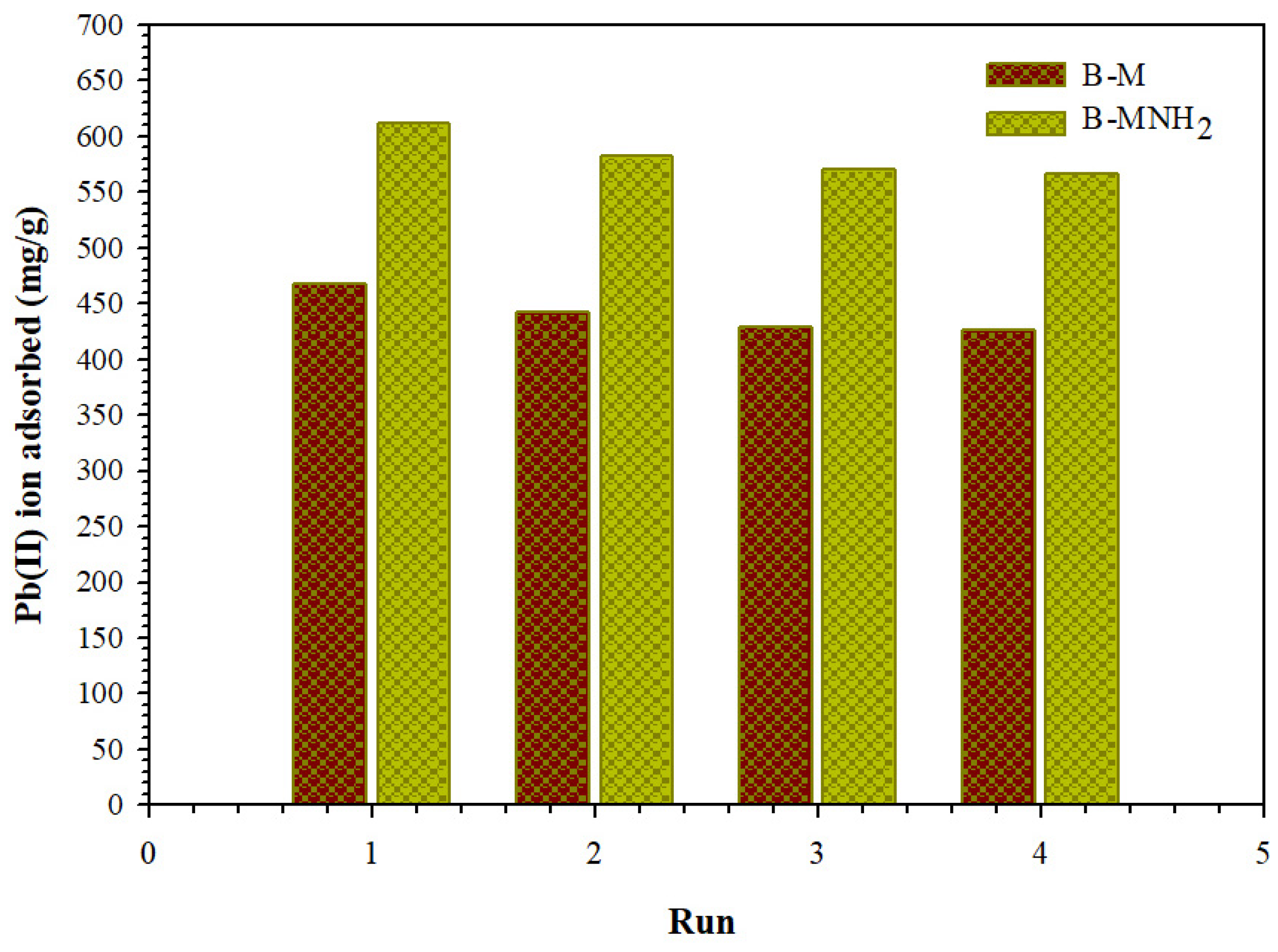
| Material | Characteristic Peak | CrI (%) | |
|---|---|---|---|
| Amorph (16.0°) | Crystal (22.4°) | ||
| RH | 771 | 1208 | 33.3330 |
| RH-D | 686 | 1218 | 77.551 |
| SB | 464 | 665 | 43.319 |
| SB-D | 564 | 1029 | 82.447 |
| Adsorbent Type | Parameter | Kinetics Model | |
|---|---|---|---|
| First Order | Second Order | ||
| Qe (mg/g) | 438.22 | 489.58 | |
| B-M | k1 (s−1) | 0.0098 | 0.00003 |
| R2 | 0.969 | 0.981 | |
| B-MNH2 | Qe (mg/g) | 596.23 | 657.46 |
| k1 (s−1) | 0.057 | 0.00004 | |
| R2 | 0.982 | 0.973 | |
| Adsorbent Type | Adsorption Isotherm | Constant | Value |
|---|---|---|---|
| Langmuir | Qe (mg/g) | 1562.18 | |
| B-M | b (L/mg) | 0.0021 | |
| R2 | 0.9844 | ||
| Freundlich | n | 4.8341 | |
| Kf | 1.1151 | ||
| R2 | 0.9789 | ||
| B-MNH2 | Langmuir | Qe (mg/g) | 717.60 |
| b (L/mg) | 0.0237 | ||
| R2 | 0.9965 | ||
| Freundlich | n | 85.827 | |
| Kf | 2.6910 | ||
| R2 | 0.9963 |
| Adsorbent Type | Adsorption Capacity (mg/g) | pHe | Reference |
|---|---|---|---|
| Magnetic functionalized by polyethyleneimine | 96.60 | 6 | [39] |
| Amine bifunctionalized on MNPs | 110.13 | 5 | [40] |
| Magnetic chitosan functionalized by L-arginine | 128.63 | 6 | [41] |
| Rice husk magnetic biocomposites (RHB-M) | 300.78 | 5 | [29] |
| Rice husk amine magnetic (RHB-MH2) | 680.19 | 5 | [29] |
| Magnetic biocomposite based on rice husk and sugarcane bagasse (B-M) | 489.58 | 5 | This study |
| Amine magnetic biocomposite based on rice husk and sugarcane bagasse (B-MNH2) | 596.23 | 5 | This study |
Publisher’s Note: MDPI stays neutral with regard to jurisdictional claims in published maps and institutional affiliations. |
© 2022 by the authors. Licensee MDPI, Basel, Switzerland. This article is an open access article distributed under the terms and conditions of the Creative Commons Attribution (CC BY) license (https://creativecommons.org/licenses/by/4.0/).
Share and Cite
Nata, I.F.; Irawan, C.; Putra, M.D.; Wijayanti, H.; Dewi, Y.S.; Meliana, Y. A Sustainable Amine Magnetic Biocomposite Based on Rice Husk–Sugarcane Bagasse Fiber for Lead and Contaminant Adsorption in Aqueous Solution. Magnetochemistry 2022, 8, 183. https://doi.org/10.3390/magnetochemistry8120183
Nata IF, Irawan C, Putra MD, Wijayanti H, Dewi YS, Meliana Y. A Sustainable Amine Magnetic Biocomposite Based on Rice Husk–Sugarcane Bagasse Fiber for Lead and Contaminant Adsorption in Aqueous Solution. Magnetochemistry. 2022; 8(12):183. https://doi.org/10.3390/magnetochemistry8120183
Chicago/Turabian StyleNata, Iryanti Fatyasari, Chairul Irawan, Meilana Dharma Putra, Hesti Wijayanti, Yuniza Shentya Dewi, and Yenny Meliana. 2022. "A Sustainable Amine Magnetic Biocomposite Based on Rice Husk–Sugarcane Bagasse Fiber for Lead and Contaminant Adsorption in Aqueous Solution" Magnetochemistry 8, no. 12: 183. https://doi.org/10.3390/magnetochemistry8120183
APA StyleNata, I. F., Irawan, C., Putra, M. D., Wijayanti, H., Dewi, Y. S., & Meliana, Y. (2022). A Sustainable Amine Magnetic Biocomposite Based on Rice Husk–Sugarcane Bagasse Fiber for Lead and Contaminant Adsorption in Aqueous Solution. Magnetochemistry, 8(12), 183. https://doi.org/10.3390/magnetochemistry8120183








